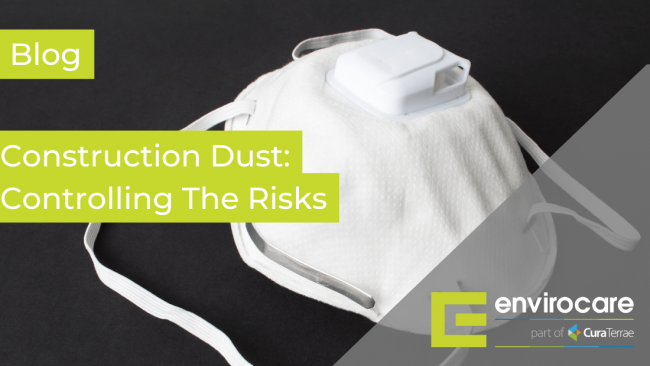Construction Dust: Controlling The Risks
25 March 2015

Construction Dust Risks
A new Construction Dust Industry Survey released by both IOSH and CDP aimed to provide an insight into issues associated with on-site dust risks, how they are controlled and show that airborne dusts are a major cause of ill health in the construction industry.
In Great Britain alone, there are over 500 deaths each year from Silica related lung cancer. Airborne dusts are the primary cause of non-asbestos related cancers in the construction industry. Some dusts (including wood dust) are respiratory sensitises.
Other health effects of dust include bronchitis, asthma and COPD. Some of these lung diseases, such as silicosis, can develop quite quickly, but most occur gradually over several years.
Construction dust can impact every person in the workplace and on site, including workers and other contractors that are unable to control the risk.
The nature of construction processes is such that processes such as dry sweeping, grit blasting and hand sanding of plaster are high energy and create a significant amount of dust. The temporary duration of construction projects means it is not reasonably practicable to integrate Engineering Controls into the process. Even though controls aren’t put into place, work practices including water suppression are generally practised, which will work to reduce the amount of dust entering the atmosphere.
Construction Dust Industry Survey Results
600 construction industry workers from around the country responded to the survey, with 61% of responses coming from safety and health advisers working in the sector.
The survey was divided into sections covering construction dust risk awareness, water suppression, dust extraction, respiratory protective equipment (RPE), control through design and biographical data.
Construction is a high risk industry and when asked in relation to the survey, builders think of construction dust as a lower concern than the more obvious risks such as falls from height and other “acute” risks to health. 14% of respondents to the survey were not aware of the severe health effects, but think of it as a nuisance, whereas only a mere 3% of respondents were “fully aware” of the risks.
When asked what priority they think the industry currently puts on the control of construction dust risks, a total of 44% of responders to the survey answered ‘very little’, with only 12.5% answering that they feel it is ‘a priority health issue’.
In general workers felt that there was a current lack of priority and awareness given to the risks by companies and very little attempt to design out construction dust risks, as well as an over reliance on RPE within the industry. More than 50 per cent of those surveyed said RPE was provided most or all of the time, however less than a fifth of individuals received appropriate face fit testing. Through the CDP, manufacturers and suppliers are looking at how better to educate the industry in the importance of selecting the right RPE, wearing it correctly and ensuring that masks fit properly.
However, there seemed to be an ever improving picture of control for dust through the use of water suppression, and better compliance by those who are more educated in the controls needed and risks faced.
Future plans are for the Construction Dust Partnership (CDP) to use these construction dust industry survey results as a benchmark from which to direct new initiatives and raise awareness via new projects and measure improvements in attitude and workplace behaviours, whilst working with manufacturers and suppliers to better educate the industry in the importance of using the correct RPE, how to wear it properly and ensuring they fit correctly.
Controlling The Risks
In order to Control Exposure from construction dust and protect employees, the COSHH regulations recommend that air sampling for dust be carried out on a regular basis. Dust sampling is carried out through the use of personal samplers, which coupled with observation from a qualified occupational hygienist can identify any problem areas and make recommendations on ways of reducing exposure. Results from this monitoring can be tailored to any shift length to give a true measure of exposure.
Step 1 – Reduce The Risks
Before beginning work, try and find ways of reducing the amount of dust you create:
- Use the correct size of building materials, therefore requiring less cutting.
- Use less powerful tools.
- Try and use Silica free abrasives where possible.
Step 2 – Control The Dust
Once the risk of construction dust has been reduced, the following methods can be used to control the remaining dust from the environment / workplace:
- Water is often used to dampen down dust clouds.
- Enclose work tops to help stop any dust escaping.
- Limit the number of people near the work space and rotate those doing the task regularly.
- On-tool extraction or general mechanical ventilation can be used to remove dust as it is being produced. This Local Exhaust Ventilation (LEV) system is fitted directly onto the tool. A general commercial vacuum is not appropriate.
Step 3 – Respiratory Protective Equipment (RPE)
RPE is often provided as an addition and not an alternative to the reduction and control of construction dust. Respiratory protective equipment is the last line of protection, so you will need to make sure it:
- Is suitable for your type of work / environment. Masks can be uncomfortable to wear for long periods of time. Powered RPE can help to minimise this.
- Fits the user correctly. Face fit testing is required to guarantee appropriate protection and tight fitting mask users must be clean shaven.
- Is adequate for the amount and type of dust. All respiratory protective equipment has an ‘Assigned Protection Factor’ (APF) which outlines how much protection it provides the wearer. The general level for construction dust is set at an APF of 20, which means the wearer will only breathe in one twentieth of the amount of dust in the air.
Step 4 – Educate Staff
Making sure staff are educated in your on site controls is equally important:
- Ensure workers know about all dust risks and how their health can be effected.
- All staff should be able to use and look after all ‘Personal Protective Equipment’ (PPE) and RPE.
- Attend any Health Surveillance where it is needed and know what to do if something goes wrong.
- Make sure they know how to use all dust controls, check that they are working and ultimately follow the correct work methods.
Step 5 – Review The Controls
Once you have made sure all of the right controls are in place, you will need to double check that they are all working correctly:
- Make sure procedures are in place to ensure work is done in the correct way.
- Check that your controls are effective. Does the workplace still seem dusty? You may need to carry out COSHH Air Monitoring.
- Ensure all equipment is maintained, instructions within maintenance manuals are followed and check for signs of damage on a regular basis.
- Make sure all non disposable RPE are clean and maintained. Change RPE filters and replace old disposable masks as recommended.
- Examinations of any on tool or Local exhaust ventilation extraction system should be tested at least every 14 months via LEV testing.
Experts in Silica and Construction Dust Monitoring
Envirocare can provide assistance by carrying out independent UKAS accredited air quality testing and Silica Dust Monitoring within the workplace. We currently service a wide range of industries. This experience allows us to conduct COSHH monitoring and COSHH Risk Assessments that are relevant and appropriate to the process operating. Our service includes expert technical advice tailored to the needs of the individual business. These include:
- Assessing operative exposure to respirable dust and silica levels and ensure levels are not above permitted Workplace Exposure Limit (WEL) Values.
- Thorough workplace observations and recommended actions in ensuring you meet your obligations in reducing exposure to as low as is reasonably practicable.
- Recommend further control measures to be put in place in order to reduce the risk of ill health to employees.
Call us on 01274 738668 or fill out our Envirocare Enquiry Form for any queries regarding COSHH air monitoring, risk assessments, silica, construction dust or any of our many other accredited Environmental and Occupational Hygiene services.
